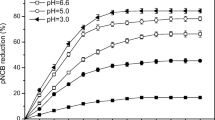Abstract
In order to maintain the quantity of ferrous ions, two eco-friendly chelating agents (CAs), i.e., sodium citrate (Citrate) and sodium gluconate (Glu), have been introduced into a traditional iron activated sodium persulfate (PS) system (Fe2+/PS). The results indicated that the PS/CA/Fe2+ oxidation could be an effective method for BDE209 removal. Effects of the chelating agents, reagents dosage, and pH were evaluated in batch experiments. Glu was observed to be more effective than citrate. In addition, the rate constants (k 1) of BDE209 removal indicated a quadratic curve relationship with initial persulfate concentrations (k 1 = −0.019 × [PS]0 2 + 0.031 × [PS]0 + 0.007, R 2 = 0.933, [PS]0 = 0.1–1.0 M) and a good linear relationship with initial ferrous contents (k 1 = 0.109 × [Fe2+]0 + 0.002, R 2 = 0.943). Furthermore, as a reducing agent, ascorbic acid (H2A) could enhance the degradation rate of BDE209, which might be because H2A accelerated the transformation process from Fe3+- to Fe2+-gluconate complexes.






Similar content being viewed by others
References
Chu W, Wang Y, Leung H (2011) Synergy of sulfate and hydroxyl radicals in UV/S2O8 2−/H2O2 oxidation of iodinated X-ray contrast medium iopromide. Chem Eng J 178:154–160
Curtin MA, Taub IA, Kustin K, Sao N, Duvall JR, Davies KI, Doona CJ, Ross EW (2004) Ascorbate-induced oxidation of formate by peroxodisulfate: product yields, kinetics and mechanism. Res Chem Intermed 30:647–661
Deng J, Shao Y, Gao N, Deng Y, Zhou S, Hu X (2013) Thermally activated persulfate (TAP) oxidation of antiepileptic drug carbamazepine in water. Chem Eng J 228:765–771
Fukuchi S, Nishimoto R, Fukushima M, Zhu Q (2014) Effects of reducing agents on the degradation of 2,4,6-tribromophenol in a heterogeneous Fenton-like system with an iron-loaded natural zeolite. Applied Catalysis B Environmental 147:411–419
Han D, Wan J, Ma Y, Wang Y, Li Y, Li D, Guan Z (2015) New insights into the role of organic chelating agents in Fe(II) activated persulfate processes. Chem Eng J 269:425–433
Huang A, Wang N, Lei M, Zhu L, Zhang Y, Lin Z, Yin D, Tang H (2013) Efficient oxidative debromination of decabromodiphenyl ether by TiO2-mediated photocatalysis in aqueous environment. Environmental Science & Technology 47:518–525
Huang A, Zhang Z, Nan W, Zhu L, Jing Z (2015) Green mechanochemical oxidative decomposition of powdery decabromodiphenyl ether with persulfate. J Hazard Mater 302:158–165
La Guardia MJ, Hale RC, Harvey E (2006) Detailed polybrominated diphenyl ether (PBDE) congener composition of the widely used penta-, octa-, and deca-PBDE technical flame-retardant mixtures. Environmental Science & Technology 40:6247–6254
Lei Y, Zhang H, Wang J, Ai J (2015) Rapid and continuous oxidation of organic contaminants with ascorbic acid and a modified ferric/persulfate system. Chem Eng J 270:73–79
Lei M, Wang N, Zhu L, Zhou Q, Nie G, Tang H (2016) Photocatalytic reductive degradation of polybrominated diphenyl ethers on CuO/TiO2 nanocomposites: a mechanism based on the switching of photocatalytic reduction potential being controlled by the valence state of copper. Appl Catal B Environ 182:414–423
Liang C, Bruell CJ, Marley MC, Sperry KL (2004) Persulfate oxidation for in situ remediation of TCE. II Activated by chelated ferrous ion Chemosphere 55:1225–1233
Liang C, Huang CF, Chen YJ (2008) Potential for activated persulfate degradation of BTEX contamination. Water Res 42:4091–4100
Liang C, Liang CP, Chen CC (2009) pH dependence of persulfate activation by EDTA/Fe(III) for degradation of trichloroethylene. J Contam Hydrol 106:173–182
Liang SH, Kao CM, Kuo YC, Chen KF (2011) Application of persulfate-releasing barrier to remediate MTBE and benzene contaminated groundwater. J Hazard Mater 185:1162–1168
Liu D, Ma J, Qiu X, Zhao Y, Lin Y, Yang Q, Gao Z, Zhu T (2014) Gridded field observations of polybrominated diphenyl ethers in soils of North China. Archives of Environmental Contamination & Toxicology 66:1–9
Peyton GR (1993) The free-radical chemistry of persulfate-based total organic carbon analyzers. Mar Chem 41:91–103
Santos MS, Alves A, Madeira LM (2015) Chemical and photochemical degradation of polybrominated diphenyl ethers in liquid systems - a review. Water Res 88:39–59
Tsitonaki A, Petri B, Crimi M, Mosbæk H, Siegrist RL, Bjerg PL (2010) In situ chemical oxidation of contaminated soil and groundwater using persulfate: a review. Environmental Science & Technology 40:55–91
Wang N, Zhu L, Lei M, She Y, Cao M, Tang H (2011) Ligand-induced drastic enhancement of catalytic activity of Nano-BiFeO3 for oxidative degradation of bisphenol a. ACS Catal 1:1193–1202
Yan J, Min L, Zhu L, Anjum MN, Jing Z, Tang H (2011) Degradation of sulfamonomethoxine with Fe3O4 magnetic nanoparticles as heterogeneous activator of persulfate. J Hazard Mater 186:1398–1404
Yan J, Zhu L, Luo Z, Huang Y, Tang H, Chen M (2013) Oxidative decomposition of organic pollutants by using persulfate with ferrous hydroxide colloids as efficient heterogeneous activator. Separation & Purification Technology 106:8–14
Zhen W, Deng D, Yang L (2014) Degradation of dimethyl phthalate in solutions and soil slurries by persulfate at ambient temperature. J Hazard Mater 271:202–209
Acknowledgments
This research was supported by projects of the National Natural Science Foundation of China (41371467), the Shanghai Pujiang Program (15PJD013), and the National Key Research and Development Program (2016YFD0800405).
Author information
Authors and Affiliations
Corresponding authors
Additional information
Responsible editor: Philippe Garrigues
Rights and permissions
About this article
Cite this article
Peng, H., Xu, L., Zhang, W. et al. Enhanced degradation of BDE209 in spiked soil by ferrous-activated persulfate process with chelating agents. Environ Sci Pollut Res 24, 2442–2448 (2017). https://doi.org/10.1007/s11356-016-7965-6
Received:
Accepted:
Published:
Issue Date:
DOI: https://doi.org/10.1007/s11356-016-7965-6




